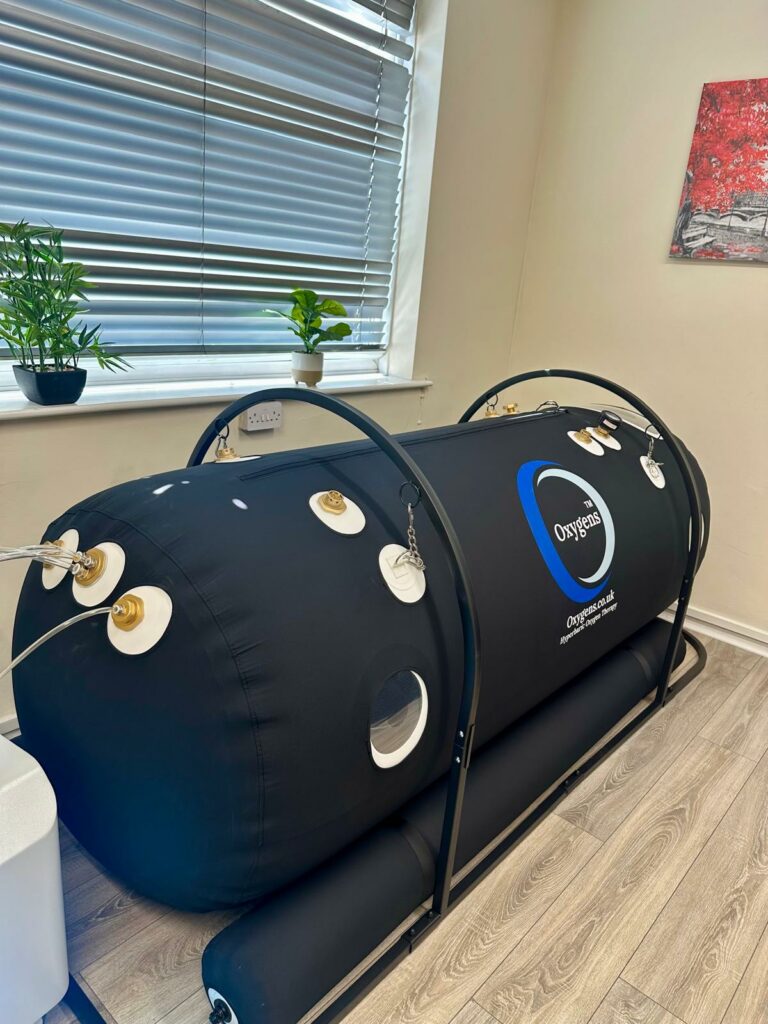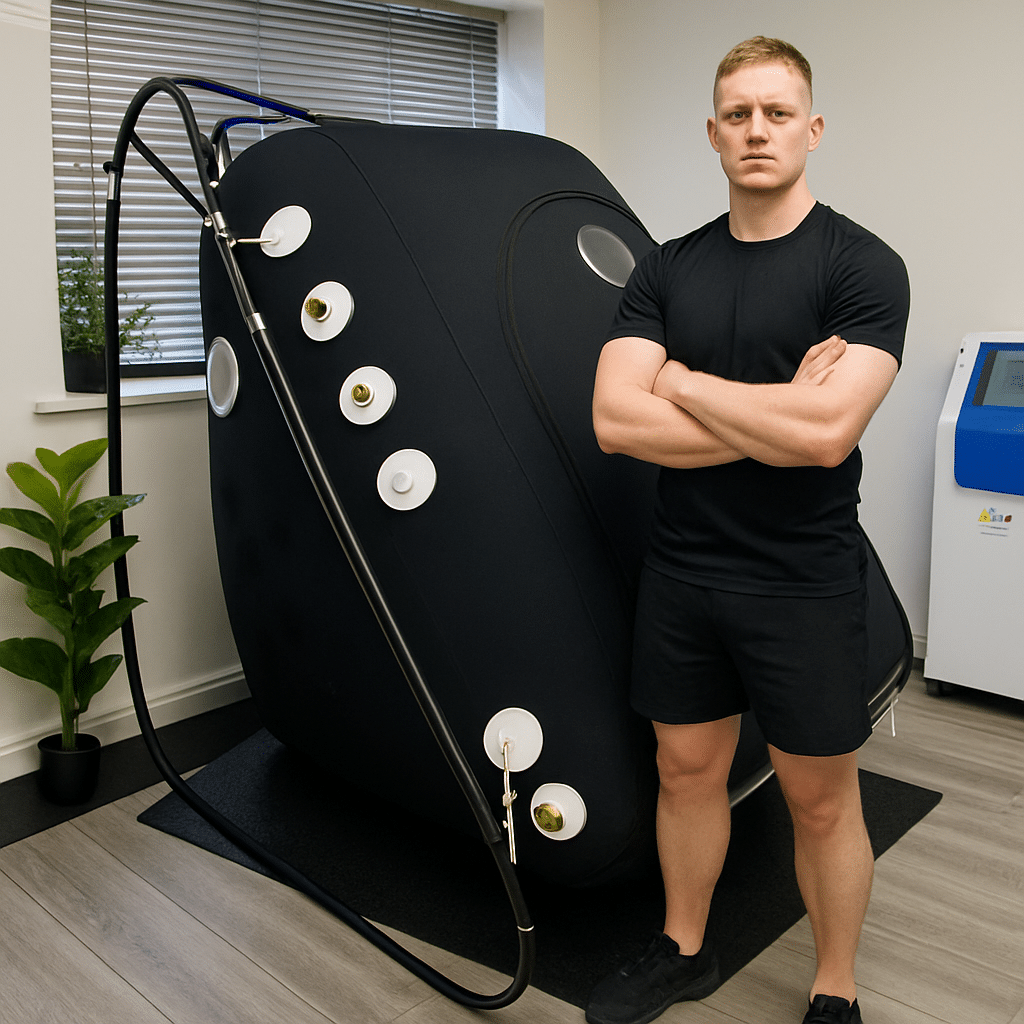You’ve probably heard whispers about them in changing rooms or spotted them in the background of glossy training facility photos. That’s right, those sleek, sci-fi-looking pods that athletes climb into after training. An oxygen chamber might sound like something from a space mission, but it’s increasingly becoming a staple in the world of elite sport.
And here’s the thing: it’s not just the footballers, sprinters, or Olympians using them. Endurance cyclists, weekend triathletes, even ultra-marathoners are giving them a go and for good reason.
So, what actually is an oxygen chamber?
In the simplest terms, it’s a sealed environment where you breathe oxygen at a higher pressure than you’d find in everyday life. The idea is that by increasing both the amount of oxygen you breathe and the pressure it’s delivered at, your body can absorb more of it into the bloodstream.
The most common version athletes use is called a hyperbaric oxygen chamber, or sometimes simply a “bariatric chamber” if it’s designed for larger users or has extra room for comfort. “Bariatric” in this context doesn’t mean it’s for weight loss (common misconception!). It just means the chamber can comfortably accommodate people of different body shapes and sizes.
Why athletes are obsessed with them
When you push your body to the limit, whether that’s smashing out sprints on the track or grinding up a brutal hill climb, your muscles produce microtears. It’s part of how you get fitter and stronger, but it comes with the dreaded side effects: soreness, inflammation, and fatigue.
Now here’s the clever part. More oxygen means more fuel for your body’s recovery systems. In an oxygen chamber, you can take in up to three times more oxygen than usual. That oxygen-rich blood travels around your body, helping to repair damaged tissue, flush out lactic acid, and reduce swelling.
There’s even evidence to suggest it speeds up the healing of stubborn injuries, which is why you might find one tucked away in the physio room of a Premier League club.
A quick story from the pitch
A few years back, an England rugby player (no names, but let’s just say he’s known for his speed down the wing) tore a hamstring just weeks before a major tournament. The initial prognosis? Six weeks out, minimum. But thanks to an aggressive recovery plan involving daily sessions in a hyperbaric oxygen chamber, he was back on the pitch in just over three.
It wasn’t magic. No, it was science giving nature a helpful shove.
Little-known fact: They’ve been around longer than you think
While oxygen chambers sound cutting-edge, they’ve actually been used for decades in medicine especially for treating divers with decompression sickness (“the bends”). Hospitals have used them to help with chronic wounds, carbon monoxide poisoning, and even severe infections.
What’s changed in recent years is accessibility. These days, you don’t need to be in hospital or on a Navy ship to use one. Private clinics, gyms, and even some home setups are available. Though the top-tier, medical-grade versions are still the most effective.
The “bariatric chamber” advantage for athletes
If you’ve ever been in a tight wetsuit after a long swim, you know how claustrophobic small spaces can feel. That’s why the bariatric chamber is such a game-changer. It’s designed to be more spacious, making it ideal for:
- Athletes who want to bring in a laptop, phone, or book during their session
- People with broader builds (think rowers, heavyweight lifters, or rugby props)
- Those who simply prefer not to feel like they’re in a submarine! While submarines are cool, they can feel too claustrophobic at times!
The extra space doesn’t compromise the benefits. You’re still getting the same oxygen-rich environment, just with more room to stretch out.
What it actually feels like inside

The first time I stepped into an oxygen chamber, I wasn’t sure what to expect. I’d imagined bright lights, a hissing sound, and maybe the slight panic of being sealed in. The reality? Surprisingly relaxing.
The pressure change is the main thing you notice. Your ears pop a bit, like when you’re on a plane, but that’s it. After a few minutes, you forget you’re breathing higher-concentration oxygen. Most athletes use the time to listen to a podcast, meditate, or just zone out.
Sessions usually last anywhere from 30 minutes to two hours. The sweet spot for recovery seems to be around an hour. And when you climb out, there’s often a noticeable lightness, a kind of post-sauna clarity, but without the sweat.
Can it make you faster?
Here’s where it gets interesting. While oxygen chambers aren’t magic performance boosters on their own (you can’t just lounge in one and expect a new PB), the recovery benefits mean you can train harder, more often, without burning out.
A marathon runner who recovers faster from their Sunday long run can push the pace in Tuesday’s interval session. A weightlifter who bounces back from a brutal leg day can keep their programme on track without skipping sessions. Over time, that consistency leads to better performance.
Common myths about oxygen chambers
“It’s just breathing oxygen! I could do that with a mask at home.”
Not quite. The key difference is the pressure. The increased pressure in a hyperbaric or bariatric chamber forces more oxygen into your blood plasma, not just your red blood cells. You simply can’t replicate that with a normal oxygen mask at sea level.
“They’re dangerous for healthy people.”
Used correctly, by a reputable provider, oxygen chambers are very safe. The main discomfort is the ear-popping from pressure changes, which you can equalise just like on a plane.
“Only pros need them.”
While elite athletes have been early adopters, plenty of everyday runners, cyclists, and gym-goers use them for recovery, injury rehab, or even just a wellness boost.
Easier to Access Than Ever

These days, getting your hands on an oxygen chamber isn’t the logistical nightmare it once was. You don’t need to book a slot weeks in advance at a specialist clinic — though that’s still an option. Many athletes now hire them for home use, making it easy to fit sessions around training schedules, or even buy their own outright for the ultimate convenience. Whether you opt for a compact model or a spacious bariatric chamber, setting one up is surprisingly straightforward, and you can run it without a team of medics hovering nearby. It’s essentially plug in, zip up, and breathe — which makes regular recovery work far more accessible than it used to be.
How to make the most of it
If you’re considering trying an oxygen chamber, here are a few tips from athletes who swear by them:
- Time it right – Post-training sessions seem to deliver the biggest recovery bang for your buck.
- Don’t overdo it – One hour is usually plenty. Spending all afternoon inside won’t make you superhuman.
- Hydrate – Oxygen can make you feel a little dry; drink water before and after.
Pair it with other recovery tools – Foam rolling, good nutrition, and proper sleep still matter. The chamber is an add-on, not a replacement.
Where the future’s headed
The technology is evolving quickly. We’re already seeing portable oxygen chambers that fold down for storage, and software that tracks your usage and recovery metrics. There’s even talk of chambers designed for team use! Imagine a post-match recovery room where an entire squad can sit together, re-oxygenating like it’s the most casual thing in the world.
Some researchers are looking at pairing oxygen therapy with cold exposure, red light therapy, or even specific breathing techniques to further enhance the effects. If it works, the sports science world might just lose its collective mind.
A final word from the track
A sprinter friend of mine likes to say, “Training makes you tired, recovery makes you faster.” And that’s really the point here. Whether you’re eyeing a podium finish or just chasing a personal best, your ability to bounce back from hard sessions is what determines your long-term progress.
For a growing number of athletes, the oxygen chamber, whether the snug traditional style or the roomy bariatric chamber, is becoming the not-so-secret weapon in that fight for faster recovery, fewer injuries, and better performance.
So the next time you hear someone mention they’ve “just been in the pod,” you’ll know they’re not talking about binge-watching a TV series. They’re giving their body a dose of oxygen-powered recovery magic.
FAQs About Oxygen Chambers and Recovery
Not at all. While Premier League footballers and Olympians may have been early adopters, plenty of amateur athletes, fitness enthusiasts, and even people recovering from injuries use oxygen chambers. They’re becoming far more accessible, whether through clinics, hire services, or home purchase.
A bariatric chamber is simply a larger, more spacious version of a standard oxygen chamber. It’s designed to comfortably fit bigger users (think rugby forwards or heavyweight lifters) or anyone who prefers a less confined space. Functionally, both deliver the same benefits, such as increased oxygen absorption for recovery and healing.
Yes, when used as directed and from a reputable provider, oxygen chambers are considered very safe. The most common sensation you’ll notice is ear-popping from the pressure change, similar to being on a plane. Regular sessions are common among athletes without adverse effects.
Not directly. Spending time in an oxygen chamber won’t replace your training. But by speeding up recovery, reducing inflammation, and helping injuries heal, it allows you to train harder and more consistently. Over time, that consistent training is what makes you fitter, stronger, and potentially faster.
Most sessions last between 30 minutes and two hours. Around one hour tends to be the sweet spot for recovery. Going longer doesn’t necessarily mean extra benefits, so it’s best to follow recommended guidelines.
No. If you hire or buy an oxygen chamber, it usually comes as a complete setup. It’s a matter of plugging it in, zipping yourself inside, and letting the chamber do its job. Bariatric chambers are particularly user-friendly if you want extra comfort and space.
During the session, you’ll notice the pressure change in your ears, but that settles quickly. Some people describe feeling calm or energised afterwards, while others notice reduced soreness and a clearer head like a post-spa refresh but for your muscles.
Not really. Oxygen therapy has been used for decades in medicine. From treating divers with “the bends” to helping chronic wounds heal. The sporting world is simply adapting a proven treatment for performance and recovery. With research continuing, it looks set to become even more mainstream.

